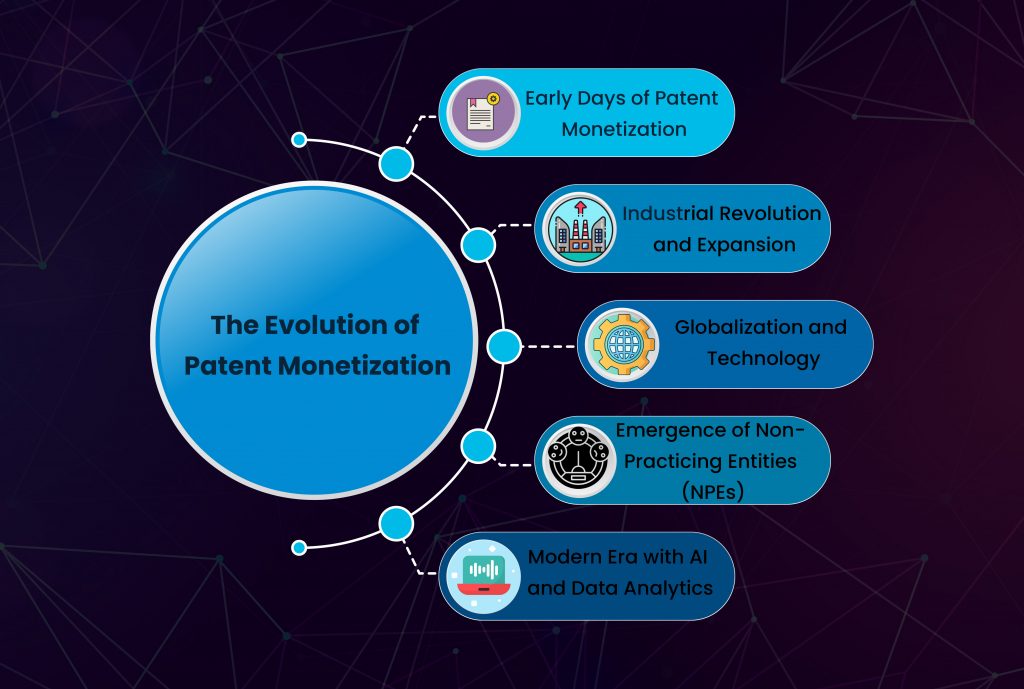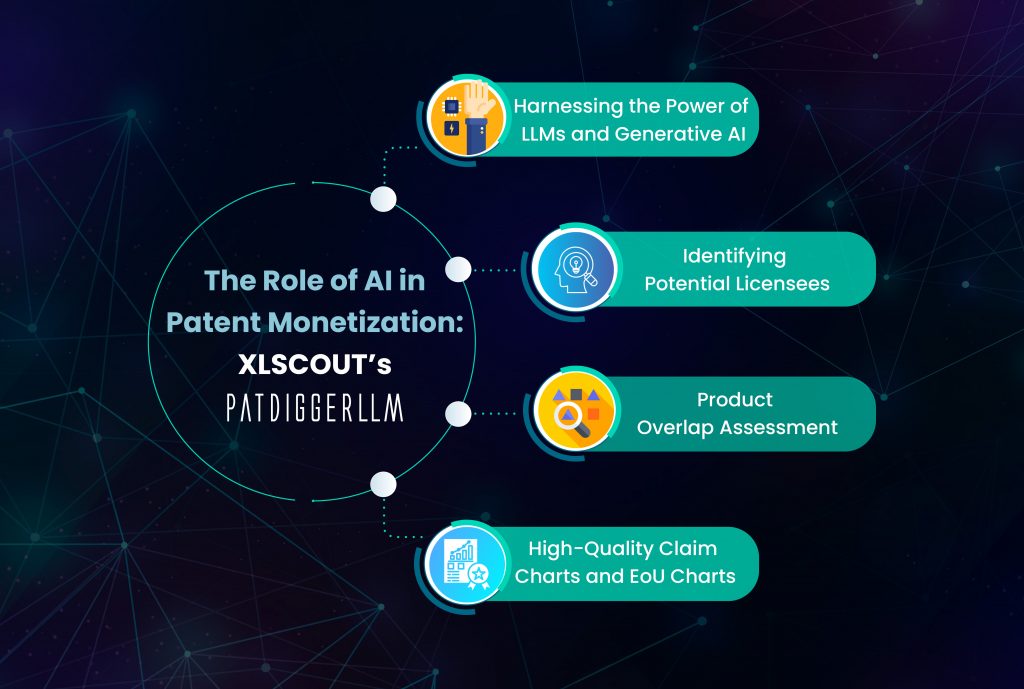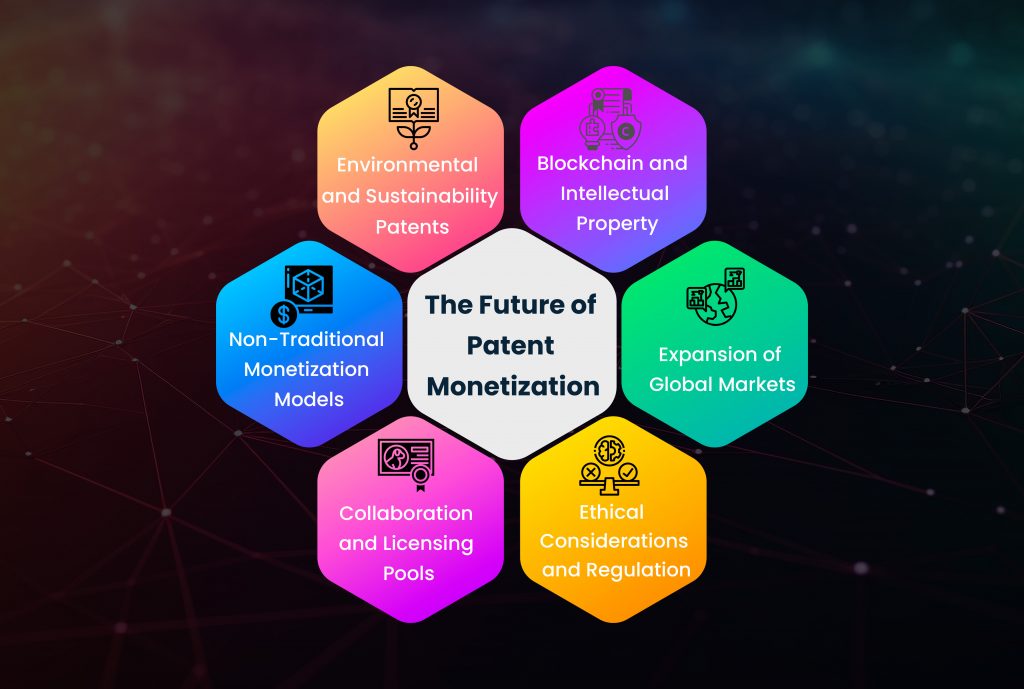
In the dynamic world of intellectual property, identifying potential licensees for your patents can be a daunting task, often requiring a deep understanding of market trends, industry players, and legal intricacies. However, with the advent of Artificial Intelligence (AI), patent monetization strategies have undergone a transformative shift. This blog explores how AI is revolutionizing the process of identifying potential licensees, making it more efficient, data-driven, and effective.
We will delve into the role of AI in patent analysis, market research, valuation, and negotiation, shedding light on its potential to unlock new opportunities and maximize the value of your intellectual property portfolio. Join us as we navigate the fascinating intersection of technology and intellectual property and discover how AI is becoming an indispensable tool in the toolbox of patent monetization professionals.
The Importance of Effective Patent Monetization
Effective patent monetization is a crucial aspect of managing intellectual property assets and deriving maximum value from them. Patents, which grant exclusive rights to inventors or organizations for their innovations, can be powerful tools for generating revenue, protecting innovations, and maintaining a competitive edge in the marketplace. Understanding the importance of effective patent monetization is essential for businesses and individuals alike.
First and foremost, effective patent monetization enables inventors and organizations to recoup their research and development investments. Developing innovative technologies often requires substantial financial resources and years of effort. Patents provide a legal framework that allows inventors to commercialize their inventions while protecting them from unauthorized use by competitors. By monetizing these patents, inventors can not only recover their investments but also fund future research and innovation endeavors.
Moreover, patent monetization plays a vital role in promoting innovation. Knowing that they can reap financial rewards from their inventions, inventors, and organizations are incentivized to invest in research and development. This fosters a culture of innovation, driving progress in various industries and ultimately benefiting society as a whole.
Effective patent monetization also helps companies maintain a competitive advantage. In today’s fast-paced business landscape, staying ahead of competitors is crucial. Patents can provide a strong barrier to entry, making it challenging for others to replicate or compete with a patented technology. By monetizing patents strategically, companies can not only generate revenue but also secure their position in the market.
Furthermore, patents can be valuable assets that enhance a company’s overall valuation. When seeking investors, partners, or potential buyers, a robust patent portfolio can significantly increase a company’s perceived worth. Investors are often more inclined to support businesses with a clear strategy for patent monetization, as it demonstrates a commitment to protecting and capitalizing on intellectual property.
The Evolution of Patent Monetization

The landscape of patent monetization has evolved significantly over the years, reflecting changes in technology, business practices, and legal frameworks. This evolution has been driven by the need for inventors and organizations to adapt to an ever-changing environment and maximize the value of their intellectual property. Let’s explore how patent monetization has evolved over time.
1. Early Days of Patent Monetization
In the early days of the patent system, which dates back to the 17th century, patents were primarily used as instruments of royal privilege, granting exclusive rights to the patentee in exchange for disclosing their inventions. These early patents were often associated with specific industries, such as textile manufacturing, and were typically granted for a limited duration.
2. Industrial Revolution and Expansion
The Industrial Revolution in the 18th and 19th centuries marked a significant shift in patent monetization. As innovations and industries expanded rapidly, patents became more valuable tools for protecting inventions and profiting from them. This era saw the rise of patent pools and patent assertion entities (PAEs), which aggregated patents and enforced them against infringing parties.
3. Globalization and Technology
In the late 20th century and early 21st century, globalization and advancements in technology revolutionized patent monetization once again. The internet and digital technologies made it easier to identify potential infringers and engage in licensing agreements globally. Companies began to view their patent portfolios not just as defensive tools but also as valuable assets for generating revenue.
4. Emergence of Non-Practicing Entities (NPEs)
The emergence of non-practicing entities, often referred to as patent trolls, brought a new dimension to patent monetization. NPEs acquire patents solely for the purpose of asserting them against other companies, sometimes leading to contentious legal battles and debates about the ethics of patent enforcement.
5. Modern Era with AI and Data Analytics
In the modern era, we are witnessing a transformation in patent monetization strategies, thanks to the integration of Artificial Intelligence (AI) and data analytics. AI-powered tools are being used to identify potential licensees, assess the value of patents, and streamline negotiation processes. This data-driven approach is making patent monetization more efficient and effective.
Targeted Licensing Strategies with AI Insights
In the world of patent monetization, the ability to formulate targeted licensing strategies is paramount. Here, we explore how Artificial Intelligence (AI) insights are revolutionizing the way patent holders approach licensing, making it more precise, efficient, and ultimately more profitable.
- Data-Driven Decision Making: AI, with its vast data processing capabilities, enables patent holders to make informed decisions based on a wealth of information. It can analyze patent landscapes, market trends, and competitive intelligence, providing valuable insights into potential licensing opportunities. By tapping into these AI-driven insights, patent holders can strategically identify patents with high licensing potential.
- Identifying the Right Licensees: One of the key challenges in patent monetization is finding the right licensees—those organizations that can benefit from and have the resources to utilize a patented technology. AI tools can scan a multitude of data sources, including public records, industry publications, and company profiles, to identify potential licensees with a high degree of accuracy. This precision eliminates much of the guesswork associated with traditional licensing efforts.
- Customized Licensing Terms: AI can also assist in crafting customized licensing terms. By analyzing historical licensing agreements and market benchmarks, AI can suggest terms that align with industry standards while maximizing the value of the patent. This level of customization can lead to more successful negotiations and mutually beneficial agreements.
- Competitive Analysis: AI insights extend beyond potential licensees to competitive analysis. Patent holders can leverage AI to assess their competitors’ patent portfolios and identify areas of overlap or gaps that may present licensing opportunities. This proactive approach allows patent holders to stay ahead of the competition and capitalize on their intellectual property assets.
- Predictive Analytics: AI can even offer predictive analytics to forecast future licensing trends and opportunities. By analyzing historical data and industry developments, AI can help patent holders anticipate which technologies or patents are likely to be in high demand in the future, allowing for strategic patent acquisition and positioning.
Identifying Potential Licensees with Precision
In the realm of patent monetization, one of the most critical steps is identifying ideal licensees—those organizations that possess a genuine interest in a patented technology and the capability to leverage it effectively. With the advent of advanced technologies like Artificial Intelligence (AI) and data analytics, the process of identifying ideal licensees has become more precise and efficient than ever before.
- Targeted Data Analysis: AI-driven tools excel at sifting through vast datasets to identify potential licensees with precision. By analyzing market data, patent databases, and industry trends, AI can generate a shortlist of companies that are most likely to benefit from a particular patent. This targeted data analysis significantly reduces the time and effort required for licensee identification.
- Customized Criteria: AI can be programmed to consider specific criteria when identifying potential licensees. For example, patent holders can specify parameters such as company size, geographic location, technology focus, and revenue to narrow down the pool of potential candidates. This customization ensures that the identified licensees align with the patent holder’s strategic goals.
- Real-time Monitoring: AI-powered systems can provide real-time monitoring of industry developments and company activities. This means that patent holders can stay up-to-date with potential licensee activities and assess their interest in relevant technologies as soon as they arise. Real-time monitoring ensures that opportunities are not missed.
- Competitive Intelligence: AI can also offer insights into the competitive landscape. By analyzing competitors’ patent portfolios and their licensing activities, patent holders can identify opportunities to approach companies that may be facing technology gaps or infringement issues. This proactive approach can lead to successful licensing negotiations.
- Risk Assessment: AI can assist in risk assessment by evaluating the financial stability and litigation history of potential licensees. This helps patent holders make informed decisions and avoid entering into agreements with companies that may pose a risk to the patent’s value or security.
In essence, this not only streamlines the licensing process but also maximizes the chances of successful agreements that benefit both parties involved. As AI technology continues to evolve, it will play an increasingly vital role in optimizing patent monetization strategies.
Maximizing Revenue with AI-Driven Monetization
In today’s competitive business landscape, patent monetization has evolved beyond a passive strategy into an active revenue-generation tool. Artificial Intelligence (AI) has emerged as a key enabler, empowering patent holders to maximize revenue through data-driven insights and strategic decision-making. Here, we explore how AI-driven monetization strategies are reshaping the intellectual property landscape and helping patent owners unlock the full potential of their assets.
- Portfolio Optimization: AI-driven tools can analyze patent portfolios comprehensively. By assessing the quality, relevance, and market potential of each patent, AI helps patent holders identify which patents to monetize and when. This optimization ensures that resources are directed towards patents with the highest revenue-generating potential.
- Licensing Strategy Enhancement: AI doesn’t just assist in identifying potential licensees; it also optimizes licensing strategies. It can recommend pricing models, royalty rates, and negotiation tactics based on historical data and industry benchmarks. These data-driven strategies enhance the chances of successful licensing agreements and maximize revenue streams.
- Global Market Analysis: AI can provide insights into global market dynamics, enabling patent holders to identify lucrative markets and target potential licensees more effectively. This international perspective broadens the scope for monetization and taps into opportunities that may have otherwise been overlooked.
- Competitive Intelligence: AI-powered competitive analysis allows patent holders to stay ahead of industry trends and competitor activities. By monitoring patent litigation, technology acquisitions, and product releases, patent owners can proactively approach companies that may require their technology or face infringement challenges.
- Predictive Analytics: Perhaps one of the most valuable aspects of AI-driven monetization is its ability to predict future trends and opportunities. By analyzing historical data and market trends, AI can forecast which technologies are likely to gain prominence, enabling patent holders to position themselves strategically to maximize revenue in emerging markets.
- Continuous Improvement: AI doesn’t stop at initial monetization efforts. It continuously refines strategies based on real-world outcomes and feedback, ensuring that revenue-generation efforts are dynamic and adaptable.
As technology continues to advance, AI’s role in monetization is poised to expand further, offering patent owners increasingly sophisticated tools to harness the full value of their innovations.
The Role of AI in Patent Monetization: XLSCOUT’s Patdigger LLM

In the ever-evolving world of patent monetization, the incorporation of Artificial Intelligence (AI) has emerged as a game-changer. One noteworthy example of AI’s transformative impact in this field is XLSCOUT’s Patdigger LLM. This innovative platform leverages Large Language Models (LLMs) and Generative AI to revolutionize the way potential licensees are identified and how product overlap on patents is assessed. Moreover, Patdigger LLM provides high-quality claim charts and Evidence of Use (EoU) charts, adding immense value to the patent monetization process.
1. Harnessing the Power of LLMs and Generative AI
Patdigger LLM employs state-of-the-art Large Language Models and Generative AI algorithms, which are designed to understand and generate human-like text. This capability allows the platform to sift through vast volumes of patent documents, legal texts, and technical literature with remarkable precision and speed. By comprehending the nuances of patent language and technical jargon, Patdigger LLM significantly streamlines the initial stages of patent monetization.
2. Identifying Potential Licensees
One of the primary functions of Patdigger LLM is to identify potential licensees for patents. Through advanced natural language processing and machine learning, the tool scours public records, market intelligence, and company profiles to pinpoint organizations that might benefit from licensing a particular patent. This process is not only efficient but also remarkably accurate, reducing the need for exhaustive manual research.
3. Product Overlap Assessment
Patdigger LLM goes beyond mere licensee identification. It also excels at assessing product overlap. By analyzing the patent claims and the products or technologies in question, the platform can identify potential conflicts or areas of synergy. This information is invaluable for patent holders, as it informs licensing negotiations and strategic decision-making.
4. High-Quality Claim Charts and EoU Charts
Patdigger LLM doesn’t stop at identification and assessment. It also aids in the creation of high-quality claim charts and Evidence of Use (EoU) charts. These visual representations are essential during licensing negotiations and legal proceedings, providing a clear and compelling illustration of patent infringement or relevance.
XLSCOUT’s Patdigger LLM represents a significant advancement in patent monetization strategies. By harnessing the capabilities of LLMs and Generative AI, it offers a comprehensive solution for identifying potential licensees, assessing product overlap, and creating persuasive claim charts and EoU charts. As the patent monetization landscape continues to evolve, tools like Patdigger LLM are poised to play a pivotal role in maximizing the value of intellectual property portfolios.
The Future of Patent Monetization

The world of patent monetization is on the cusp of significant transformation, driven by technological advancements, evolving business models, and changing legal landscapes. As we peer into the future, several trends and developments emerge that are poised to reshape the patent monetization landscape in profound ways.
1. Blockchain and Intellectual Property
The integration of blockchain technology with intellectual property rights is a promising avenue for the future. Blockchain’s immutable ledger can provide a transparent and secure way to track the ownership and licensing of patents. Smart contracts on blockchain platforms can automate royalty payments, reducing administrative overhead and enhancing trust in licensing agreements.
2. Expansion of Global Markets
The globalization of markets will continue to create opportunities for patent holders to monetize their assets on a global scale. Companies will increasingly explore licensing agreements and partnerships with international organizations, leading to a more interconnected and dynamic patent monetization landscape.
3. Ethical Considerations and Regulation
As AI and blockchain technologies advance, ethical considerations surrounding patent monetization will come to the forefront. Regulators and policymakers will likely develop new frameworks to address issues such as patent trolling, fair licensing practices, and privacy concerns related to data-driven monetization strategies.
4. Collaboration and Licensing Pools
Collaborative efforts and patent pools will become more prevalent as a means to streamline licensing and reduce litigation risks. Companies will recognize the benefits of pooling their patents for collective monetization, fostering innovation, and minimizing the threat of costly legal disputes.
5. Non-Traditional Monetization Models
Emerging business models, such as the sharing economy and open-source initiatives, may impact patent monetization. Companies may explore unconventional approaches to licensing, emphasizing broader access to technology and cooperative innovation.
6. Environmental and Sustainability Patents
As sustainability and environmental concerns take center stage, patents related to green technologies and eco-friendly solutions will gain prominence. The future of patent monetization may witness a surge in licensing agreements for technologies that address climate change and ecological challenges.
In conclusion, the future of patent monetization promises a landscape marked by innovation, collaboration, and responsible practices. With AI at its core, combined with blockchain’s transparency and ethical considerations guiding its evolution, patent monetization will continue to adapt to the changing needs of businesses and society at large. As the patent landscape evolves, companies and inventors must stay attuned to these trends to navigate the ever-changing world of patent monetization successfully.

